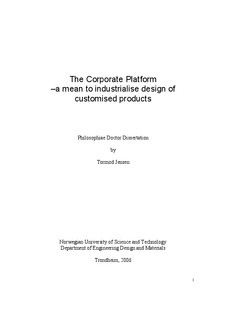| dc.contributor.author | Jensen, Tormod | nb_NO |
| dc.date.accessioned | 2014-12-19T12:26:00Z | |
| dc.date.available | 2014-12-19T12:26:00Z | |
| dc.date.created | 2007-11-19 | nb_NO |
| dc.date.issued | 2006 | nb_NO |
| dc.identifier | 122989 | nb_NO |
| dc.identifier.isbn | 82-471-8053-7 | nb_NO |
| dc.identifier.uri | http://hdl.handle.net/11250/241297 | |
| dc.description.abstract | In the last century there has been a vast increase in global competitiveness. The flow of products across borders is greater than ever before and the focus on price and performance increased. Companies feel this increased competition and need to develop products that meet the customer’s individual needs and at the same time still be competitive on the price. It is in these situations design for product platform show their strength. It offer the companies the opportunity to sell products to different market segments and at the same time provide increased reuse of assets within the company. For products with a structure that allows configuration possibilities, there have been several methods of modularisation and product platform designed to accommodate these challenges. For products not suitable for a configuration design, there have been no models to follow. This thesis proposes the Corporate Platform model to develop a product programme. The model focuses on how to structure the product programme in order to deliver customised products and at the same time focus on reuse within the company. The model has been developed around the crash box product manufactured by Hydro Aluminium Structure. This is a component in the bumper system of cars and its purpose is to absorb all the energy in a low speed crash (16 km/h).
The Corporate Platform model is intended for the design team and their managers in the process of developing a structured product programme for all the product variants. It is primarily developed to industrialize the development process of customised product variants. The product programme involves an understanding of the market, the product and the manufacturing processes as well as the dynamic aspects related to the product’s life, in order to provide insight into lean product variant design. The model focuses not only on one product variant, as a traditional product development methods does, but all the aspects of several product platforms with a range of product variants.Central relationships in product variant design are made explicit and related to strategic thinking. The model consists of three elements: Market, Product Platform and Manufacturing.
• Market covers the inputs and drivers for the product variant design and the process of segmentation of the customer’s product preferences.
• Product Platform development focuses on arranging and aligning the product features to sort out the balance between distinctiveness and commonalities in the products. This is aligned with the existing products and supplemented with new product concepts, so that the decided product range can be met. All this is in close relationship with the production processes for the products.
• Manufacturing focuses on the transfer of best design and production knowledge from one product variant onto the next.
These three elements form the base from which customised product variants can be leveraged. The models also put the attention on the dynamic aspects in launching and managing new industrial processes with their associated product variants. The Corporate Platform model is a broad model covering the central aspects of establishing a product programme. | nb_NO |
| dc.language | eng | nb_NO |
| dc.publisher | Fakultet for ingeniørvitenskap og teknologi | nb_NO |
| dc.relation.ispartofseries | Doktoravhandlinger ved NTNU, 1503-8181; 2006:145 | nb_NO |
| dc.title | The Corporate Platform – a Mean to Industrialise Design of Customised Products | nb_NO |
| dc.type | Doctoral thesis | nb_NO |
| dc.contributor.department | Norges teknisk-naturvitenskapelige universitet, Fakultet for ingeniørvitenskap og teknologi, Institutt for produktutvikling og materialer | nb_NO |
| dc.description.degree | PhD i produktutvikling og materialer | nb_NO |
| dc.description.degree | PhD in Engineering Design and Materials | en_GB |
